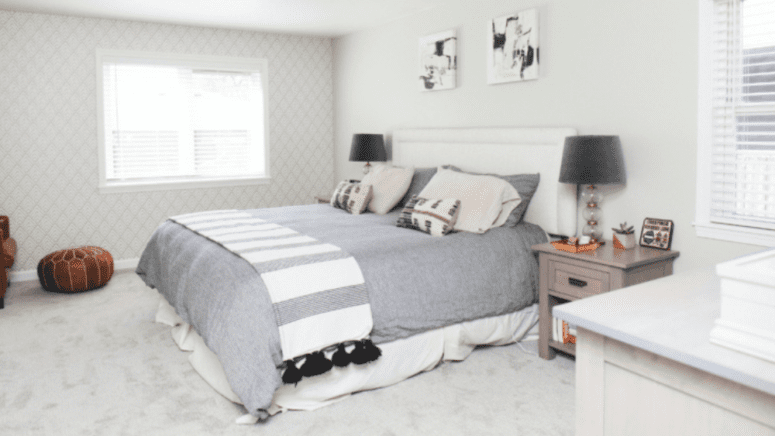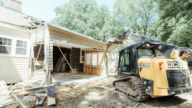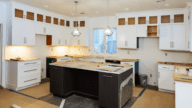Fresh Fibers: How Much Does It Cost to Carpet a 10×12 Room?
- Published on
- 11 min read
-
 Christine Bartsch, Contributing AuthorClose
Christine Bartsch, Contributing AuthorClose Christine Bartsch Contributing Author
Christine Bartsch Contributing AuthorFormer art and design instructor Christine Bartsch holds an MFA in creative writing from Spalding University. Launching her writing career in 2007, Christine has crafted interior design content for companies including USA Today and Houzz.
-
 Sam Dadofalza, Associate EditorClose
Sam Dadofalza, Associate EditorClose Sam Dadofalza Associate Editor
Sam Dadofalza Associate EditorSam Dadofalza is an associate editor at HomeLight, where she crafts insightful stories to guide homebuyers and sellers through the intricacies of real estate transactions. She has previously contributed to digital marketing firms and online business publications, honing her skills in creating engaging and informative content.
In the flooring world, classic hardwood and trendy options like luxury vinyl plank tend to steal the spotlight. But soft flooring still accounts for 33% of the flooring market, a sign that many homeowners are keeping warm, fuzzy carpets within their purview. If you’re looking to refresh a den, small upstairs bedroom, or newly arranged home office, one of the first questions you’ll likely have is: how much does it cost to carpet a 10×12 room?
This carpet guide rounds up price estimates from across the web, details your main cost considerations, and gives you the budgeting tools you need for a quick but impactful carpet swap in your home. You’ll be happy to know, it’s one of the more affordable flooring options you can go for. And in a space this small — you can update your carpet on the cheap.
Carpet installation cost breakdown
The right carpeting can add coziness, comfort, and a little warmth under the feet. Fresh carpeting in modern style will also transform a room made dingy by dirty, years-old fibers. Expect to pay between $3 and $11 per square foot for the luxury of enjoying brand-new carpet in your home. In a 10×12 space or 120 square feet, that amounts to a project totaling approximately $360 to $1,320, depending on the carpet material, style, and the addition of padding underneath.
Carpet
Naturally, the carpeting itself makes up a large chunk of your budget. How much you pay depends on the type of carpet you pick. Actual carpet prices from Home Depot indicate you can find options for as low as $.61 to as high as $1.75 per square foot. For a 10×12 room, that works out to approximately $73 to $210 budgeted toward the carpet material. Factors that impact the cost of the carpet include fiber, cut style or construction, and pile height.
Padding
Don’t be tempted to skimp or skip on the padding below your carpet just because you’ll never see it. “Padding matters. It feels so nice to walk on a nice, thick pad in bare feet, so it’s worth it to splurge on great padding,” says Shannon Watkins, a top real estate agent in the McDonough, Georgia area.
If you’ve ever walked on a carpet covering concrete with no padding in between, you know how hard it is on your feet and your knees. But padding isn’t just nice to walk on—it serves as added insulation to keep heat and cold from seeping through the floor, dampens sound, and reduces allergens, too. Carpet padding costs between $0.75 and $2.00 per square foot, which amounts to a range of $90 to $240 for your 10×12 project.
Installation
You’ll also need to account for any labor costs associated with the carpet installation. Home Depot offers free services in some locations with a minimum purchase of $699. But other companies do charge for installation, either per project, room or square foot. Generally, you can expect to add between $0.50 and $1.50 per square foot for professional installation. This translates to a cost range of $60 to $180 to install carpet in a 10×12 room.
And it may be worth it to pay for installation rather than opt for free installation, depending on what services the installers provide.
“Always ask questions before contracting with a carpet company, because they don’t all offer the same services,” advises Watkins.
“One might have the lowest price, but you’ll be doing a lot of manual labor because they require you to completely empty out the room before they arrive. Another might charge a little more, but they handle moving the furniture and replacing it for you.”
Choosing a fiber and style for your 10×12 space
As mentioned, the vast discrepancy in cost between the low- and high-end ranges for carpet installation is due to factors that impact the cost of the carpet itself. These include: carpet fiber, cut style or construction, and pile height.
Carpet fiber
Carpet fiber refers to the type of material the carpet is made out of. Every fiber type comes with its own benefits and drawbacks, including durability and cost.
Nylon ($2 to $5 per square foot)
Nylon is a synthetic carpet material that stands out as the most popular choice due to its durability and versatility. You can find almost any type of texture, color, pile, or pattern in nylon fiber. It’s also known to be soft, easy to clean, and wear-resistant. However, note that it’s not stain-resistant. You’ll need to find a variety that’s been treated to be stain-resistant if the space calls for it.
Polyester ($1 to $3 per square foot)
Another synthetic option, polyester starts at a dollar per square foot, making it one of the most affordable carpet options around. It also earned a reputation for being both stain- and fade-resistant. However, some brighter-colored polyester may fade over time in direct sunlight, and polyester is generally considered less durable than nylon.
Olefin or Polypropylene ($1 to $3 per square foot)
Olefin’s selling point is in its colorfast reputation. Rather than dyed like many of its counterparts, olefin has the color constructed into the fiber, so it’s much less likely to fade or become discolored over time. However, olefin is not as durable as nylon or polyester, so it’s best to use it in low-traffic areas.
Wool ($4 to $20 per square foot)
If you’re committed to installing natural fiber carpets, wool is the way to go. It’s known for being both soft and durable, flame-resistant, hypoallergenic, and stain-resistant. Wool’s all-natural, long-lasting nature has made it synonymous with luxury and style, which is reflected in its hefty price tag.
Triexta ($3 to $8 per square foot)
Triexta is the newest man-made fiber to hit the carpet market, and it’s giving nylon a run for its money. This fiber is considerably softer than nylon, plus it’s hydrophobic — which means it repels moisture, making it resistant to both stains and moisture damage.
As an added bonus, triexta is made in part from corn (37% to be exact), which is a renewable source. Since triexta is so new, it remains to be seen if it can match nylon’s durability.
Carpet fiber cost comparison
Let’s take a look at how several online cost estimators calculate the cost of carpeting a 10×12 room in these different carpet fibers, as well as a handful of alternate flooring options.
Carpet pile and style (construction)
When comparing carpet types, there are two main factors to consider: pile and style (or construction). Pile refers to the height of the carpet, while style, or construction, refers to how the carpet fibers are woven.
Pile
Pile height falls into three main categories, which are low, medium, and high.
- Low pile carpeting
This carpet pile has very short, flat fibers, like the type you might find in a commercial office building. The short pile prevents it from catching a lot of dust and debris, making it easy to clean and able to withstand high traffic without showing wear. However, the low pile isn’t very soft or comfortable, making it best for high-traffic areas only. - Medium pile carpeting
This carpet pile strikes a balance between comfort and durability. With its mid-range fiber length, the medium pile is comfortable enough for bedrooms and living rooms, while still maintaining a level of durability. While it does catch more dust and debris than low-pile carpet, its pile is short enough to be easily cleaned. - High pile carpeting
The height of luxury, high pile carpeting cannot be beaten in terms of plush, cushy comfort. And it’s a perfect option in areas where you need some sound dampening. High-pile carpet feels like walking on air, but its luxurious comfort comes at a price. That high pile is a dust, debris, and pet hair magnet, which requires frequent cleaning. It’s also more prone to being crushed underfoot, so you’ll see the impressions of foot traffic more easily than lower piles.
Style and construction
While there are a number of different carpet styles, or constructions, the five most common are, Berber/loop, Frieze/shag, pattern, plush, and textured:
- Berber/Loop carpets feature looped fibers, providing durability and a low profile, ideal for high-traffic areas.
- Frieze/Shag carpets have unique, twisted fibers that create a casual, textured look and feel, often offering softness underfoot.
- Patterned carpets combine cut and loop fibers to create distinct designs, adding a stylish and unique touch to rooms.
- Plush carpets, with their densely packed, even-cut fibers, provide a smooth, velvety surface for formal spaces.
- Textured carpets have uneven cut fibers, minimizing footprints and dirt visibility while giving a relaxed, casual vibe.
Note that the construction you select will likely impact your price:
- Berber or loop carpet ($3 to $20 per square foot)
- Frieze or shag carpet ($1 to $8 per square foot)
- Pattern or cut and loop ($2 to $6 per square foot)
- Plush ($2 to $8 per square foot)
- Textured ($1 to $12 per square foot)
Pricing out a typical carpeting project for a 10×12 room
When you look at all of the different selections that could impact your carpet budget, it’s easy to get overwhelmed with the numbers. Let’s look at how you can price out the cost to carpet your 10×12 room using the price average for the most popular carpet fiber: Nylon.
Let’s say you’ve selected a medium-pile, Berber construction, nylon fiber carpet, a mid-level thickness for your padding, and installation will cost you $1.50 per square foot.
- Carpet selection: Lightbourne nylon loop: $4.94 per square foot
- Carpet padding: TrafficMaster premium carpet pad: $.37 per square foot
- Installation: $1.50 per square foot
Cost overview:
Room size: 10x 12
Total carpet cost: $592.80
Total padding cost: $44.40
Total installation cost: $180
Total Cost: $817.20 (before taxes)
Should you carpet just one room at a time?
Now that you know how much it costs to carpet a 10×12 office, den, or guest room, you need to consider how replacing the carpet in just one room could impact the overall value of your home.
“You’re not going to see more than a dollar-for-dollar return on your investment in new flooring if that. Let’s say I give you a list price of $350,000, and then you invest $3,500 in recarpeting the whole house. That isn’t going to get you an additional $3,500, but it may help us sell faster,” explains Watkins.
In addition, installing new flooring in just one secondary bedroom (assuming you have more than one) may create an uneven aesthetic. Buyers won’t love to see four different carpets in each bedroom.
A cohesive style and design throughout the house is generally preferred over a hodgepodge of different carpet colors and styles. So if you’ve got a three-bedroom home, you need to install the same carpet in both of the secondary bedrooms.
You can get away with a different carpet in the primary bedroom suite, as long as it’s more luxurious than the carpet in the secondary bedrooms. However, the primary bedroom suite carpet should be in the same color family as the other bedrooms, and share a similar pattern (if there is a pattern in the carpeting you select) so that the differences aren’t glaringly obvious at first glance.
Similarly, you may be able to get away with different flooring in various rooms if each room has a different dedicated purpose, say one is a guest bedroom and the other has office built-ins.
Consider your carpet choices carefully
Carpet selection involves so much more than picking out the color you want at the flooring shop. You need to consider the durability of the fibers, the look and feel of the construction and pile, and how installation costs and services will impact your overall remodeling budget.
And while you may have started with the idea of a single-room remodel project, when it comes to the carpet, it may be wiser to replace the flooring throughout the house than in a single 10×12 room.
Header Image Source: (House Method / Unsplash)






